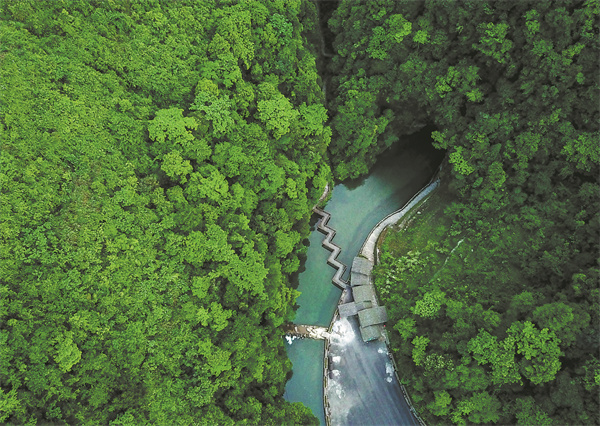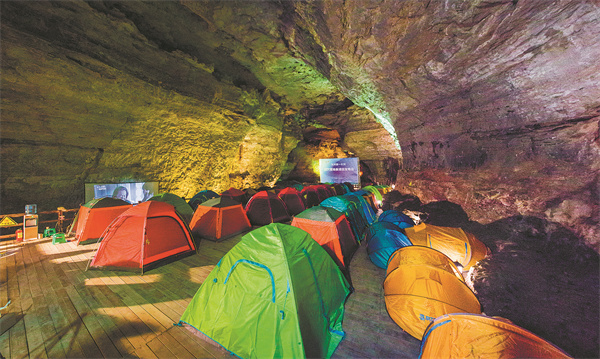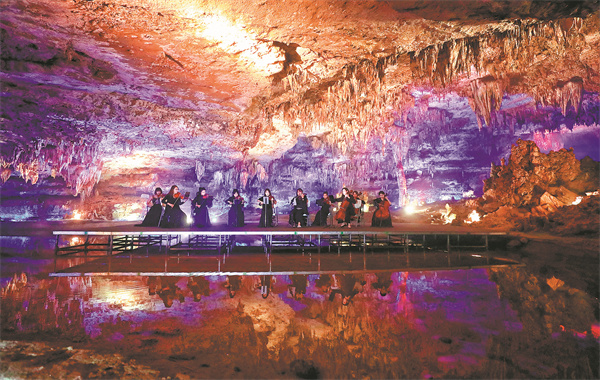
A view of the Shier Beihou scenic area.[Photo provided to China Daily]
Clad in mud-caked shoes and equally dirtied clothes and carrying a small cloth bag, French cave explorer Jean Bottazzi navigates the winding caverns deep within Suiyang county's mountains in Southwest China's Guizhou province with ease. His journey to Guizhou is fueled by a passion for caves that borders on obsession, as reported by Guizhou Radio TV Station.
Discussing the allure of cave exploration, Jean likens it to playing chess, not to capture the king but to "find it" in uncharted territories. "Cave exploration starts with imagination — pondering the cave's location, the mountain it's in, its entrance, and its exit. Then comes action: physically exploring and immersing oneself in the cave. Our role is to document and measure, paving the way for future explorations," he explains.
Born into a family of cave explorers in 1962, Jean joined the French Federation of Speleology at 16 and dedicated his life to exploring caves. His passion and commitment have earned him international recognition and the position of vice-president of the federation. This same passion draws him to Guizhou.
In 1986, at the invitation of the Institute of Geology, Chinese Academy of Geological Sciences (IGCAGS), Jean and a team of five began their cave explorations in Guizhou, marking the start of his annual visits to China ever since.
Guizhou is a prime area for karst development, making it rich in cave resources. Along with Chinese and international experts, Jean has conducted nearly 20 joint scientific explorations in Shuanghe Cave in the Shier Beihou scenic area, establishing it as Asia's longest cave.
Shuanghe Cave, hailed as a "natural karst cave museum", is China's largest karst cave group and the world's longest dolomite cave and largest celestine cave.
To date, the cave extends over 409.90 kilometers and reaches a depth of 912 meters. Explorations have uncovered fossils of ancient vertebrates, including giant pandas and bears, highlighting the site's paleontological value.
Today, the complex cave systems in Suiyang are no longer seen only by Jean and his team. More and more cave resources have been developed, becoming mysterious tourist attractions.

The underground fissure at the Shier Beihou scenic area.[Photo provided to China Daily]
Liu Dezhang, executive president of Guizhou Shier Beihou Tourism Development, explains, "Traditional cave development involves building walkways and installing lighting for tourists to sightsee the geological landscapes. However, the Shuanghe Cave scenic area has innovated cave tourism by developing outdoor sports events tailored to the features of different cave branches. For instance, in Yinhe Dong (Galaxy Cave), with its huge vertical shafts, we developed activities like abseiling and ziplining. There are no built walkways or lighting inside the cave; tourists wear custom clothing and equipment provided by us, and under the guidance of instructors, they enter the pristine caves for abseiling and exploration. The whole process is novel and exciting, especially popular among young people, outdoor enthusiasts and children."
In today's diverse and personalized tourism era, the quest for exciting and unique experiences is driving mainstream tourist demand. As a result, caves that have lain dormant for millions of years are being awakened, and a variety of niche yet highly engaging cave experiences are stimulating the public's adrenaline. The Shuanghe Cave scenic area is at the forefront, innovating with its "Cave+" tourism model to introduce new adventures.
As the Suiyang Integrated Media Center reported, Luo Jianjun, general manager of the Shuanghe Cave scenic area, shared, "In summer, we've leveraged 'Cave + Music' to enhance cave tourism, attracting visitors from afar. In winter, we pivot to cave tours and outdoor adventures, drawing winter camp study groups for educational and outdoor experiences, thus fully leveraging our cave tourism potential."

Camping in one of the caves at the Shier Beihou scenic area.[Photo provided to China Daily]
The annual Guizhou Cave Music Week, themed "Colorful Guizhou: Unique Cave Sounds" and launched for the first time last year, will return on May 1, with free concert tickets available. According to Eyesnews under Guizhou Daily, over 20 renowned singers, along with music groups and performers from the Guizhou Song and Dance Theatre, will gather at the Shier Beihou scenic area during the music week. They will present a series of top-notch audiovisual feasts, including a concert featuring Grand Songs of the Dong ethnic group and Flying Songs of the Miao people, and a symphony concert that showcases the vitality of the cave over millions of years through the "reverberation".

The concert held at the Shier Beihou scenic area last year.[Photo provided to China Daily]
From April 11 to 12, the 18th Guizhou Tourism Industry Development Conference was held in Xingyi in the province's Qianxinan Buyei and Miao Autonomous Prefecture. Themed "Promoting Deep Integration of Culture and Tourism and Building a World-class Tourist Destination", the event once again spotlighted Guizhou's rich cultural and tourism attractions on a global scale.
"Looking ahead, we aim to fully leverage our region's unique and abundant mountain resources, focusing on mountain outdoor sports and ecological wellness. By diving deep into our local ecological attributes, cultural identity and folk traditions, we're making our offerings more experiential, interactive and socially engaging to attract more young people," says Liu.
Editor Ⅰ: Zhang Wenwen
Editor Ⅱ: Wu Dan
Editor Ⅲ: Liu Guosong














